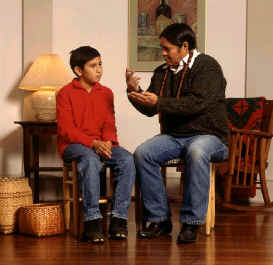|
WHAT DO I NEED TO KNOW? CONCEPTS
ABOUT LEARNING
 Native Americans share some common ways of dealing with information
Native Americans share some common ways of dealing with information
A word or two of clarification from
Andy Forsythe, teacher on the Rosebud Reservation in Mission, SD, who has been involved
with Lakota culture and Native communities
for quite a few years.
"The
suggestions of characteristics of TNA is not definitive and will not apply to
all Native people. These may be some characteristics of some traditional
individuals but will vary depending on circumstances such age, geographic
region they live in (i.e. on or off the reservation, or which community they
live in within the reservation), and most importantly their tribal
affiliations. Lakota traditions will be different from Ute traditions which
will be different from Tlingit traditions
and so on."
The following list is taken from
http://www.geocities.com/HotSprings/9569/education.html.
To find out more about each characteristic, visit that site.
-
The average Native American incorporates a
traditional learning style into daily efforts
-
Internal language is picture/emotion based
-
Interacting is generally via
body language
-
Assume that there needs to be a
4 contact approach to the given topic/subject
-
There needs to be a "safe"
environment, always
-
Dialogue is small groups oriented
-
Silence is generally [honored?] because there is a social
mixture of differing "cliques" within the classroom
-
Never single out a student
-
Facilitate a "formed group"
atmosphere prior to any instruction effort
 Native Americans
tend to regard concepts
holistically and visually/symbolically.
Native Americans
tend to regard concepts
holistically and visually/symbolically.
"In schools everywhere, there
is a strong tendency to emphasize verbal over visual symbolic thinking and to
approach situations analytically rather than holistically. It follows that
students whose cognitive tendencies do not match those school expectations are
more likely to be less academically successful (Tharp, 1989). There is
considerable evidence that Native American children suffer such a mismatch,
since by-and-large they tend to think in holistic rather than analytic terms
(Tharp, 1991). Informal learning in many Native American cultures is acquired
in a holistic context." [Instructional
Conversations in Native American Classrooms. (ERIC Identifier:
ED376733
Publication Date: 1994-12-00)]
 Native Americans value
"wait" time.
Native Americans value
"wait" time.
"...Research has shown that "wait
time"--the amount of time speakers are given to speak and respond--is
substantially longer in Native American culture than in European-American
culture."
"For Native Americans, the IC appears to
be enhanced by extended wait time. Winterton (1976) studied the effect of
extended wait time on Pueblo Indian children's conversations with a teacher.
Results indicated that extended wait time, especially when it followed
students' responses, was significantly related to the length of students'
responses and the amount of student-to-student interaction. Verbal
participation of less vocal students also increased, as did overall
unsolicited but appropriate verbal responses." [Instructional
Conversations in Native American Classrooms. (ERIC Identifier:
ED376733 Publication Date: 1994-12-00)]
 Native Americans
tend to observe before acting or questioning.
Native Americans
tend to observe before acting or questioning.
Children on Reservations learn
through observation. Theirs is a quiet way. Their minds are active, but their
actions are passive. All in good time. Observe, learn, and when you are ready,
you can perform. Many Navajo women weave a perfect rug the first time they
create it because they have observed enough to know how to weave a rug.
"Navajo and European-American
mothers were shown videotaped episodes of Navajo and European-American
children participating in a classroom. The mothers were told to rate the
children on a number of dimensions. Differences concerning one particular
episode--a European-American boy engaged in high levels of verbal and physical
activity--were especially striking: The Navajo mothers believed the high
verbal and physical activity were negative attributes (and therefore rated the
boy negatively), whereas the European-American mothers believed them to be
positive. By implication, it is possible that a European-American teacher
might negatively evaluate the overall communicative and interactional styles
of some Native American children." [Instructional
Conversations in Native American Classrooms. (ERIC Identifier:
ED376733 Publication Date: 1994-12-00)]
 Native Americans
tend to speak softly and avoid eye contact with authority.
Native Americans
tend to speak softly and avoid eye contact with authority.
"Other socio-linguistic
variables that may influence the IC between European-American teachers
and Native American children are the volume at which teachers and students
speak to each other [Native Americans tend to speak more softly (Darnell,
1979)] and expectations regarding speaker- and listener-directed gaze (Native
American students might look down to express politeness when addressed by a
teacher). This indicates, then, that communication embodies much more than
speech alone." [Instructional
Conversations in Native American Classrooms. (ERIC Identifier:
ED376733 Publication Date: 1994-12-00)]
 Native Americans
tend to respond well cooperative learning environments.
Native Americans
tend to respond well cooperative learning environments.
"The social organization of a
traditional American classroom is primarily whole-class oriented, with a
teacher who leads, instructs, and demonstrates to the whole group. Some form
of individual practice often follows, and learning is assessed by individual
achievement. This system is ineffective for children of many cultures, who
respond to this structure with a low level of attention to both the teacher
and the coursework and with a high level of attention-seeking from peers (Gallimore,
Boggs, & Jordan, 1974). Unfortunately, teachers usually attribute this
behavior to low academic motivation rather than to inappropriate social
structures (Tharp & Gallimore, 1976)."
 Native Americans
tend to not challenge authority figures.
Native Americans
tend to not challenge authority figures.
Traditional Native Americans are
taught to respect knowledge. They do not challenge authority figures. They do
not question instructors. To do so is to show disrespect.
A study of the informal learning
activity settings of Navajo and Hopi children indicated that adults regularly
assign children their chores, but leave them to perform without adult
supervision, even for difficult and complex tasks. For example, 7- or
8-year-olds are often assigned to herd sheep alone or to care for an infant
sibling. When children require assistance in fulfilling these
responsibilities, they often turn to peers or siblings. Most out-of-school
learning for these children takes place in small peer-oriented groups (Rhodes,
1989).[Instructional
Conversations in Native American Classrooms. (ERIC Identifier:
ED376733 Publication Date: 1994-12-00)]
DISCUSSION WHEEL
-
How did your teachers reinforce you
and build your confidence in school?
-
Imagine that you are in the same
school and that you were a Native American student straight from your
Reservation. How do you think you would feel with that teacher and with those
students?
-
Imagine your life at this
moment. What picture would you draw to reflect all of your activities,
involvements, relationships, commitments, etc...? Where would you be in the
drawing? What would you use to reflect the different areas of your life?
-
Imagine a person that feels
totally connected to all that is - someone, such as a native person in many
cultures, who cannot separate him/herself from the environment. What picture
might that person draw? How might it be different from yours?
APPLICATION 4
-
Design a physical classroom model
that would produce the feeling of a community or cooperative environment. As an
start, think of what the room would look like, feel like, sound like. Where
would students spend most of their time?
-
Design 2 activities for an objective
in your course that would be likely to help you capture the participation and interest of a
Native American students in meeting that objective. Describe what steps you
would take to implement those activities.
|


![]()